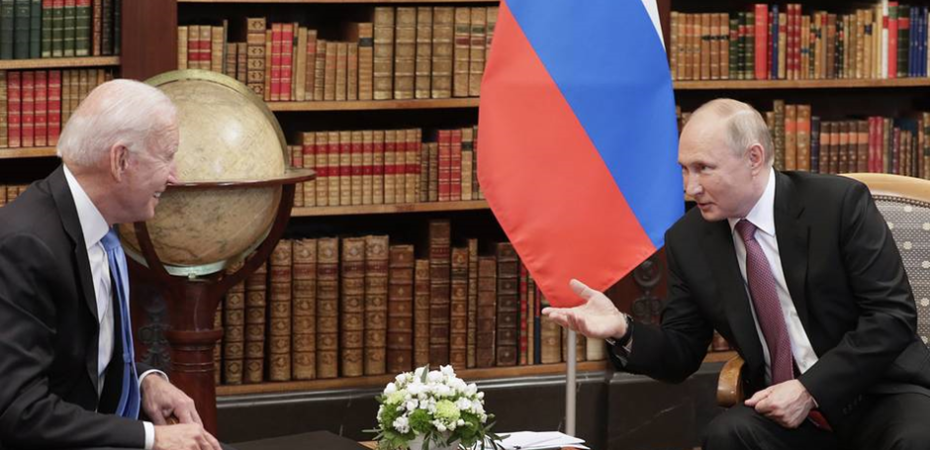On December 7 Putin and Biden held a two-hour video conference. But before we dive into the main conclusions and achievements of this meeting it is relevant to understand what brought the relationship of the two most powerful countries on the international arena to the state which may be described the best as “hanging by a thread”.
The previous background
Never-ending sanctions, reciprocal accusations of all the evil, the expulsion of diplomats, and closures of the embassies – here is a brief description of the last decade of the Russian-American relationship. But what was the trigger?

The relationship between the two countries had always been very complex but even during the Cold War, it was never that aggressive. It all started in 2004 when Baltic states, Poland and Hungary joined NATO despite guarantees not to expand NATO eastward, which were given to the USSR after the fall of the Berlin Wall. Russia took it painfully and since then the issue of NATO’s eastward enlargement has been a stumbling block to a close relationship between the two countries. However, the real deterioration in the relations started in 2014 when the USA introduced economic sanctions against Russia being at loggerheads with the actions of the Russian government during the Ukrainian crisis. Russia, in turn, introduced snapback sanctions. And just when the global community thought it could not get any worse in 2016 Russia was accused of meddling in American elections. As a consequence, a new set of sanctions was introduced and such a called “diplomatic war” started. 60 Russian diplomats and their families were urgently expelled from the United States, and access to two out-of-town residential complexes of the Russian Permanent Mission in New York and the Russian Embassy in Washington was closed, from which the American authorities had withdrawn their diplomatic status. Meanwhile, Russia took similar measures and closed an American Embassy in Saint Petersburg and expelled American diplomats. As we can see the picture is far from being perfect and exactly these conflicts brought us where we are today.
The current status

Now let’s get back to our days and the recent meeting of the two leaders. In the center of the online summit was Ukraine. While Putin noted the absence of any progress in the implementation of the 2015 Minsk agreements on the Donbas, Biden underlined the threatening nature of the movement of Russian troops near the Ukrainian borders and outlined the United States and its allies would be ready to apply sanctions in case there was a further escalation of the situation. Furthermore, the Russian president told his American counterpart that Russia is interested in reliable legal guarantees that exclude NATO expansion to the east, as well as the deployment of offensive strike weapons in neighboring states. The US has repeatedly said it is Ukraine’s right to decide its security arrangements, but Sullivan said that Biden made clear that broader strategic talks between the Nato allies and Russia were possible if the threat of invasion receded.
When discussing the bilateral agenda, Putin and Biden agreed that cooperation between the two countries is unsatisfactory, in particular, due to restrictions on the work of diplomatic missions (which took place in 2016 as it was mentioned above). Another significant aspect of cooperation between the two countries is cybersecurity and the two leaders agreed on the necessity of collaboration in this field.
A warmer future?
When it comes to the future of the relationship of the two countries we can see some improvements already. Contacts between high-ranking representatives of both administrations have also become more frequent. There is progress in Nord Stream 2 as well. According to the American newspaper Guardian, the Biden administration opposes the adoption by Congress of new sanctions against the Russian pipeline. However, we are not out of the wood yet, especially considering the situation around Ukraine. Over the past month, the United States and other Western countries have regularly stated that Russia is pulling troops and military equipment to the Ukrainian border. Western capitals warn Moscow against rash steps and threaten with new sanctions. A few hours before the presidents’ conversation, Bloomberg and CNN sources said that the West, due to the situation around Ukraine, is ready to impose sanctions, including restrictions on the conversion of the ruble and the ability of investors to buy Russian debt in the secondary market. According to CNN, members of “Putin’s inner circle”, Russian energy companies and banks, and Russia’s sovereign debt may fall under the restrictions. In the most radical, “nuclear” version, Russia is threatened to be disconnected from the SWIFT interbank system. Moscow insists that it has no military plans for Ukraine, and calls on Kyiv to fulfill the Minsk agreements, to give guarantees of non-aggression to the unrecognized republics of Donbas.
In conclusion, the relationship between Russia and America has never been perfect but from my point of view, the two countries have many fields in which they can develop collaboration: culture, space, science. As a famous proverb says: “Slow progress is steady progress”. There is a dialogue and that sounds promising already.
A cura di Anastasiia Prokofeva
Resources
https://www.nytimes.com/2017/08/31/us/politics/russia-consulate-close-retaliation.html
https://www.theguardian.com/world/2021/dec/07/joe-biden-vladimir-putin-virtual-summit-ukraine-russia
https://www.rbc.ru/politics/08/12/2021/61af0c3e9a7947ae2c8b653a
https://foreignpolicy.com/2021/06/18/russia-us-summit-biden-putin-relations/
https://edition.cnn.com/2021/11/15/politics/us-intelligence-russia-ukraine/index.html
